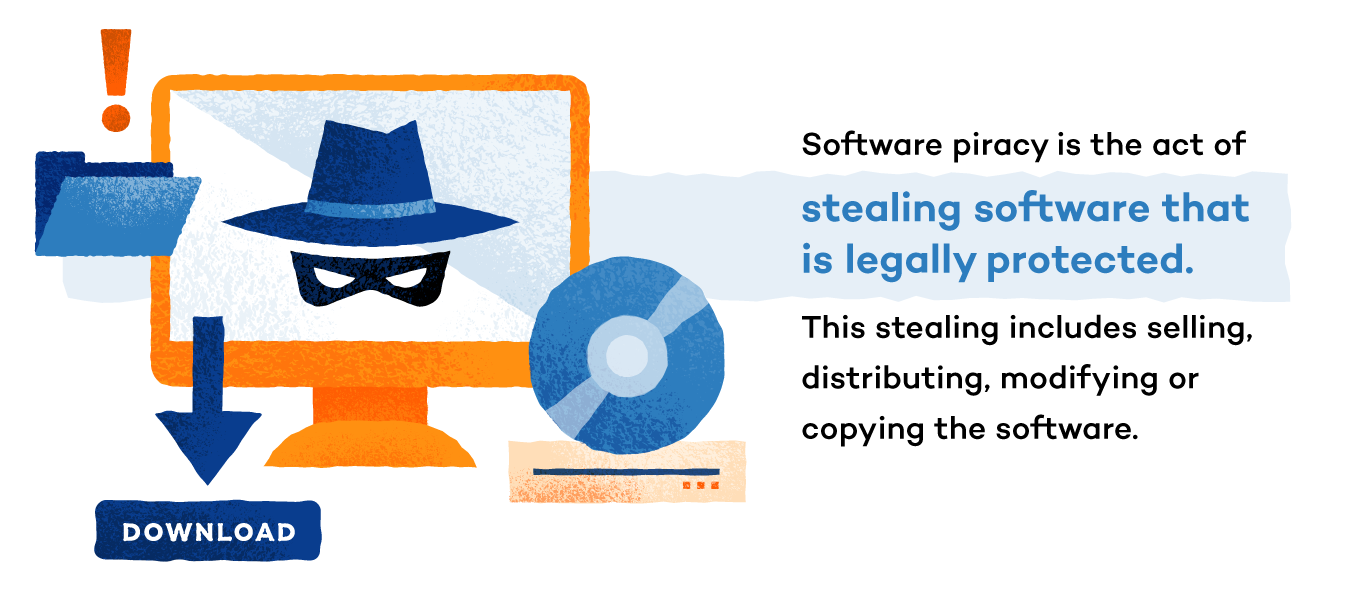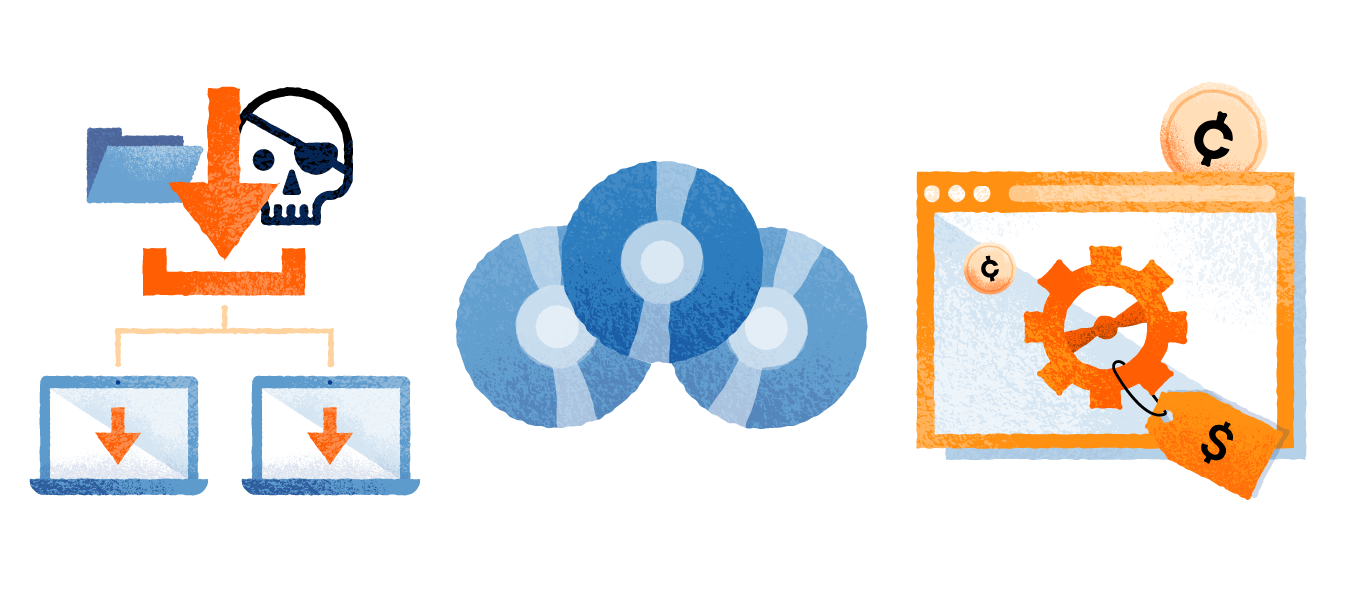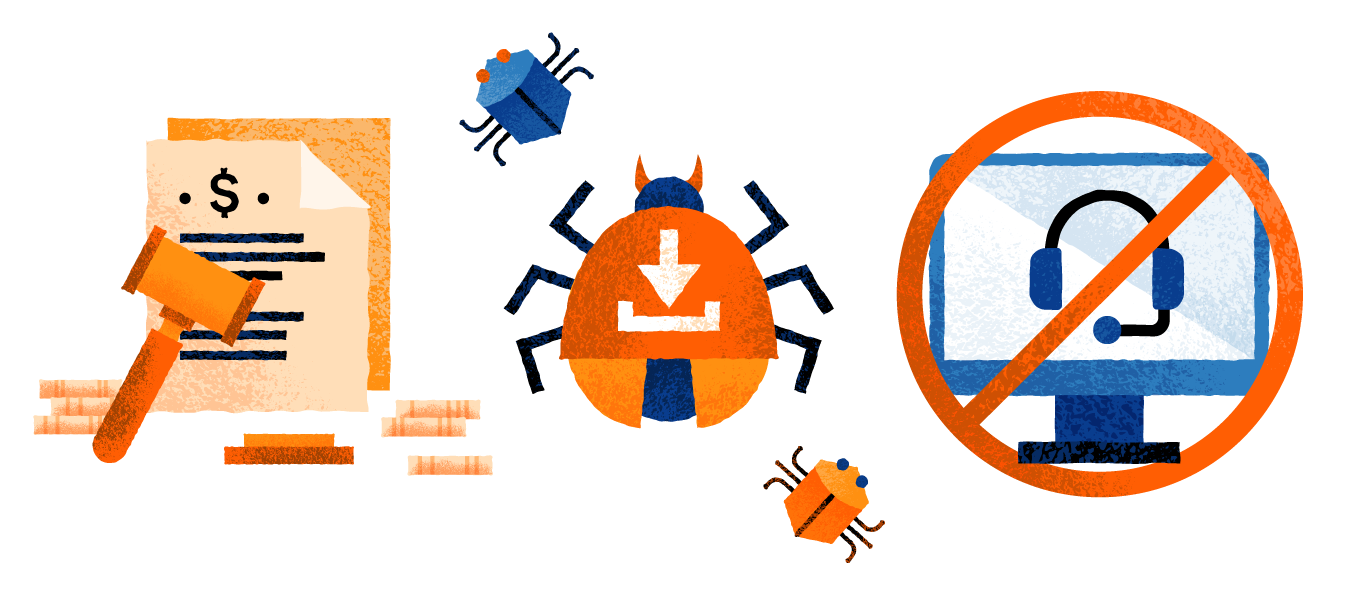Software piracy has become a worldwide issue, with China, the United States and India being the top three offenders. In 2022, 6.2% of people worldwide visited software piracy websites.
Software piracy doesn’t require a hacker or skilled coder. Any normal person with a computer can become a software pirate if they don’t know about the software laws. With such a widespread impact, it’s important to understand what software piracy is and the dangers it presents.

What Is Software Piracy?
Software piracy is the unauthorized use of legally protected software, which includes stealing, copying, distributing, modifying or selling the software. Copyright laws were originally put into place so that people who develop software (programmers, writers, graphic artists, etc.) would get proper credit and compensation for their work. When software piracy occurs, compensation is stolen from these copyright holders.
Software Piracy Regulation
Software piracy is illegal and constitutes a federal crime. The monetary penalties for those who break this law can reach up to $150,000 per instance of copyright violation. An end-user license agreement (EULA) is a license used for most software. It is a contract between the manufacturer and/or author and the end user. This agreement defines rules for software use, and not every agreement is the same. One common rule in most EULAs prohibits users from sharing the software with others.

The Dangers of Software Piracy
Software piracy may be cheaper than purchasing legitimate software, but there are many dangers that software pirates should be aware of. Individuals who continue to engage in software piracy risk harming their digital experience by allowing viruses to infect their computers or becoming an online target for authorities.
Consequences of software piracy include:
- Increased chances of software malfunction or failure: When software is obtained illegally, there is a greater chance of encountering glitches, errors or failures. Pirated software lacks the quality control measures that legitimate software uses to test or improve the software to a more functional version, resulting in compromised performance and potentially unstable systems.
- Forfeited access to support services: Training, upgrades, customer support and bug fixes are all included with legitimate software purchases. Users lose access to these services when they use pirated software, leaving them without the assistance they need to optimize their software experience.
- No warranty and lack of updates: Pirated software lacks warranties, meaning users have no resource options if it fails to work. Users who do not have access to official updates miss out on important security patches and improvements, leaving their systems vulnerable to cybersecurity threats and lacking the latest features.
- Increased risk of malware, viruses or adware: Users are more vulnerable to malware, viruses and adware when downloading unofficial software. Pirates can modify software packages to include malicious code, which puts the software and the user’s computer system at risk of compromised data.
- Slowed PC performance: Illegitimate software may contain added programs, features, or altered code that may significantly slow down a computer’s performance. This negatively impacts the user experience and puts the entire system’s stability and reliability at risk.
- Legal repercussions due to copyright infringement: Individuals who use pirated software risk serious legal consequences. Copyright infringement is a punishable offense and may cause software companies to actively pursue legal action against you. Using pirated software can result in fines, penalties and even imprisonment.
- Compatibility issues: Pirated software might not work with other programs or operating systems, resulting in data loss, formatting issues or inefficiency.
Types of Software Piracy
There are seven main types of software piracy. This variety of pirating techniques explains how people may open the door to riskware or impact their computer’s performance.
Softlifting
Softlifting is when someone purchases one version of the software and downloads it onto multiple computers, even though the software license states it should only be downloaded once. This often occurs in business or school environments and is usually done to save money. Softlifting is the most common type of software piracy.
Client-server overuse
Client-server overuse is when too many people on a network use one main copy of the program at the same time. This often happens when businesses are on a local area network and download the software for all employees to use. This becomes a type of software piracy if the license doesn’t entitle you to use it multiple times.
Hard disk loading
Hard disk loading is a type of commercial software piracy in which someone buys a legal version of the software and then reproduces, copies or installs it onto computer hard disks. The person then sells the product. This often happens at PC resale shops and buyers aren’t always aware that the additional software they are buying is illegal.
Counterfeiting
Counterfeiting occurs when software programs are illegally duplicated and sold with the appearance of authenticity. Counterfeit software is usually sold at a discounted price in comparison to the legitimate software.
Online Piracy
Online piracy, also known as Internet piracy, is when illegal software is sold, shared or acquired by means of the Internet. This is usually done through a peer-to-peer (P2P) file-sharing system, which is usually found in the form of online auction sites and blogs.

Renting
When software is rented, a copy is borrowed for a limited time without the copyright owner’s consent. While some institutions, such as libraries and universities, have special licenses to legally rent software, renting is against the terms of the software license agreement without these special permissions. It’s similar to renting a video from Redbox or a streaming platform, making copies of the rented software and repurposing it for profit.
OEM Unbundling
Original equipment manufacturer (OEM) unbundling occurs when an individual sells standalone programs initially bundled with additional products. This is like when someone sells you a security update separately rather than bundling the costs into a package that may include the update, customer support, file sharing software, license keys, and more.
Examples of Software Piracy
Software piracy may be more common than you realize. To help you understand how software piracy works, here are some common examples:
- Using cracked or pirated software downloaded from unauthorized websites: This is classified as softlifting because it involves obtaining unauthorized copies of software without purchasing valid licenses. Avoid this type of software piracy by using licensed software from authorized sources. Identify unauthorized websites by visiting official vendor sites with reviews and use trusted app stores like Google Play or the Apple App Store for downloads. Consider installing antivirus software for added security.
- Using key generators or license key cracking tools to illegally activate software: Key generators are programs that generate license keys at random using an algorithm. Key cracking tools remove or modify the software’s copy protection mechanisms to bypass the proper activation processes. This is another example of softlifting, and the best way to avoid this scenario is by going through the proper vendors and checking their online sites instead of a third-party resale site.
- Sharing software licenses beyond their intended use: Imagine a small company purchases a software license for a project management tool, allowing access for up to 10 users. However, as the workload increases, employees start sharing login credentials with colleagues beyond the permitted 10 users. This is a form of client-server overuse, as more people access the software than the license allows. Ways to prevent this include monitoring the number of logged users, implementing stronger user authentication methods and even random audits.
- Installing a single-user license without proper licensing on multiple computers: This example also falls under client-server overuse since it involves the improper installation and use of a single-user license on multiple devices.
- Changing software to disable copy protection mechanisms: This is an example of hard disk loading, when individuals tamper with software to remove copy protection mechanisms and illegally distribute it.
- Selling counterfeit software copies: Individuals selling unauthorized, fake copies of software as genuine products is an example of counterfeiting.
- Unauthorized distribution of proprietary software: Consider a person who obtains an official copy of a popular graphic design software and decides to freely share it on a file-sharing website. Others download and use this unauthorized copy, denying the software company potential revenue and infringing on copyright laws. This is a classic case of online piracy, where people distribute unauthorized copies of proprietary software over the internet.
- Purchasing software without a valid license key or special authorization: If you obtain software without a valid license, authorization, or special permissions and attempt to sell or distribute it, this is a form of renting—just like copying a video you rented from Amazon Prime and selling it online without authorization.
- Selling the contents of a software package separately rather than as a whole: This is a form of OEM unbundling since users are installing individual parts of the system instead of the entire bundled software package.
Preventing Software Piracy
There are many ways to protect yourself from unintentionally pirating software and infecting your computer with malware, including:
- Educating yourself: Educate yourself and others on the importance of legal software. Understand the terms and conditions and licensing agreements of the software you purchase.
- Checking your license keys: Ensure you have the correct license keys and follow the proper protocols when activating your software.
- Purchasing software from authorized retailers: Buy software only from credible vendors and stores; avoid third-party or noncredible sources to ensure you receive legitimate products.
- Using the latest Wi-Fi security protocols: Ensure your router uses the latest software to prevent cybercriminals from breaching your data or infecting your computer with viruses.
- Reporting suspicious software: If you encounter strange or suspicious software you believe may be pirated, report your findings to The Software Alliance (BSA).
Panda Security Protects Against Software Piracy
Keep your PC secure by only purchasing software from authorized dealers. Be aware of any software’s terms and conditions — and make sure you agree and adhere to their guidelines. Protect your device from threats or cyberattacks due to software piracy with Panda Security’s Free Antivirus for your Mac or Windows devices.






4 comments
Any possible solutions and Interventions to further help
society in regards to the topic?
Hello, Ian. Our role here is updating our services as quickly as we can to keep our customers safe, however the menace.
may I know who is the writter for this article?
It is very helpful for me